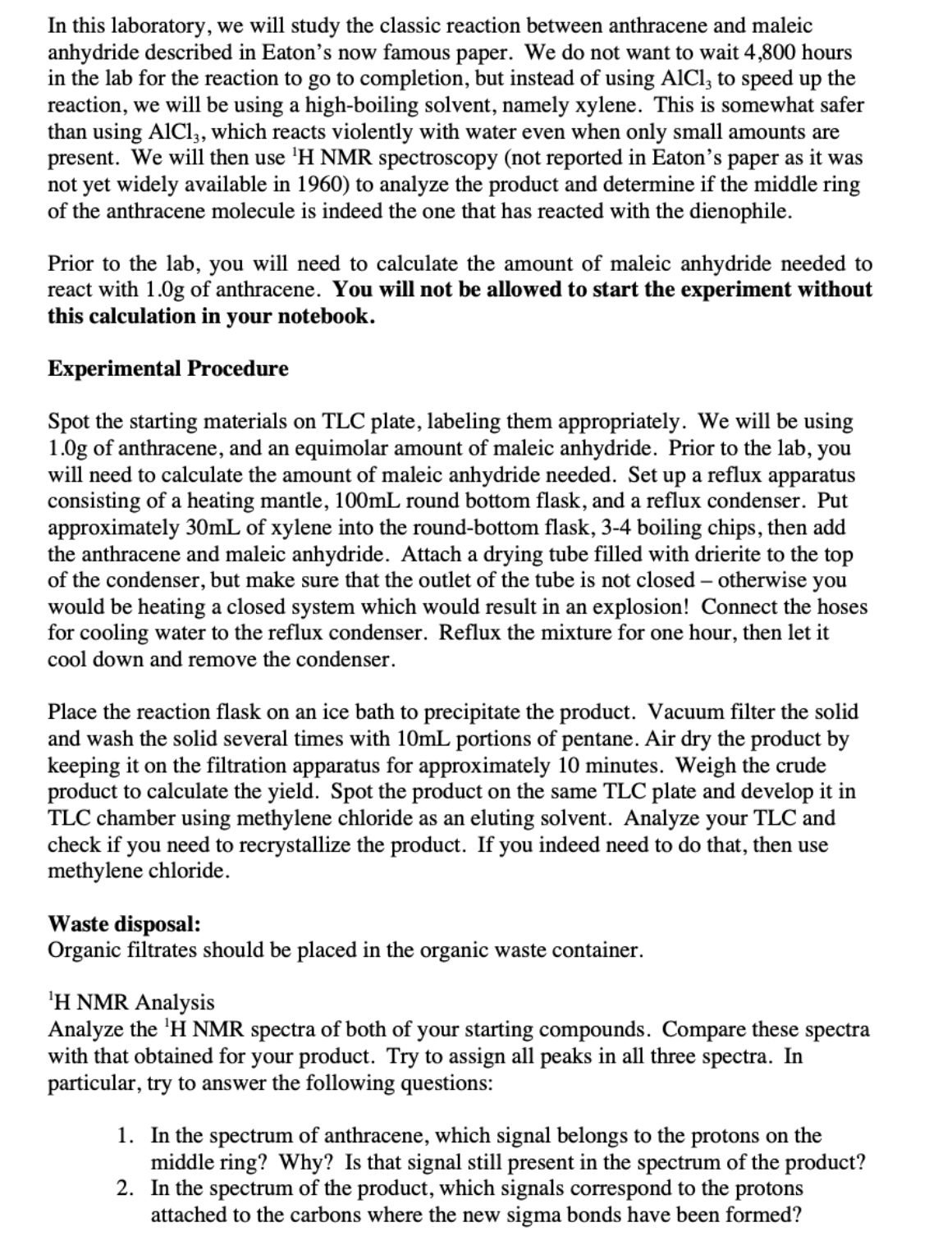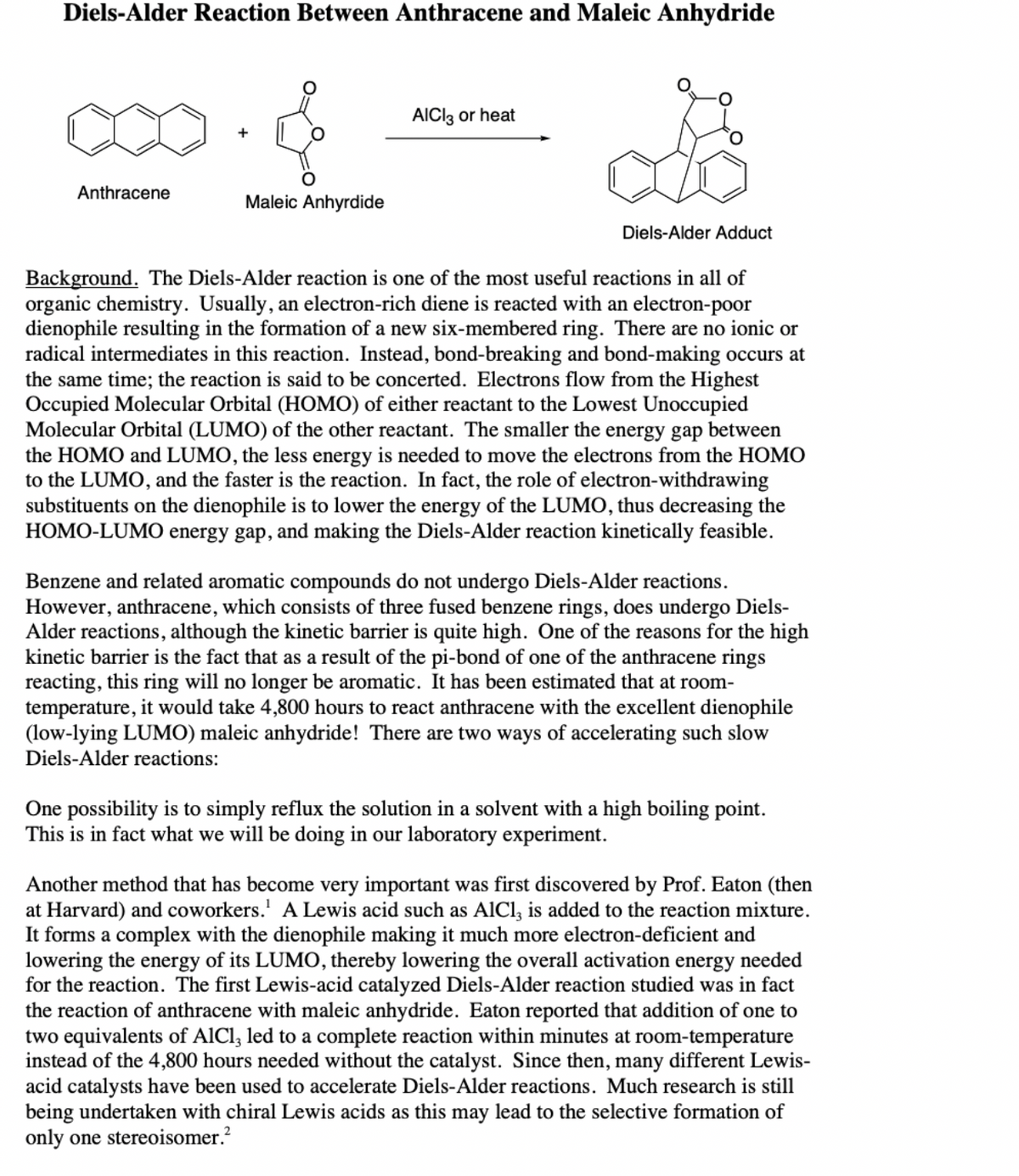Abstract: A brief and concise overview of the experiment and results (2-3 sentences). 4 Introduction: Write a brief statement, of purpose of the experiment (6-8 sentences).
Abstract: A brief and concise overview of the experiment and results (2-3 sentences). 4 Introduction: Write a brief statement, of purpose of the experiment (6-8 sentences).
Chapter14: Conjugated Compounds And Ultraviolet Spectroscopy
Section14.SE: Something Extra
Problem 41AP: Although the Diels–Alder reaction generally occurs between an electronrich diene and an...
Related questions
Question
Abstract: A brief and concise overview of the experiment and results (2-3 sentences).
4 Introduction: Write a brief statement, of purpose of the experiment (6-8
sentences).

Transcribed Image Text:In this laboratory, we will study the classic reaction between anthracene and maleic
anhydride described in Eaton's now famous paper. We do not want to wait 4,800 hours
the
in the lab for the reaction to go to completion, but instead of using AICI, to speed up
reaction, we will be using a high-boiling solvent, namely xylene. This is somewhat safer
than using AlCl,, which reacts violently with water even when only small amounts are
present. We will then use 'H NMR spectroscopy (not reported in Eaton's paper as it was
not yet widely available in 1960) to analyze the product and determine if the middle ring
of the anthracene molecule is indeed the one that has reacted with the dienophile.
Prior to the lab, you will need to calculate the amount of maleic anhydride needed to
react with 1.0g of anthracene. You will not be allowed to start the experiment without
this calculation in your notebook.
Experimental Procedure
Spot the starting materials on TLC plate, labeling them appropriately. We will be using
1.0g of anthracene, and an equimolar amount of maleic anhydride. Prior to the lab, you
will need to calculate the amount of maleic anhydride needed. Set up a reflux apparatus
consisting of a heating mantle, 100mL round bottom flask, and a reflux condenser. Put
approximately 30mL of xylene into the round-bottom flask, 3-4 boiling chips, then add
the anthracene and maleic anhydride. Attach a drying tube filled with drierite to the top
of the condenser, but make sure that the outlet of the tube is not closed – otherwise you
would be heating a closed system which would result in an explosion! Connect the hoses
for cooling water to the reflux condenser. Reflux the mixture for one hour, then let it
cool down and remove the condenser.
Place the reaction flask on an ice bath to precipitate the product. Vacuum filter the solid
and wash the solid several times with 10mL portions of pentane. Air dry the product by
keeping it on the filtration apparatus for approximately 10 minutes. Weigh the crude
product to calculate the yield. Spot the product on the same TLC plate and develop it in
TLC chamber using methylene chloride as an eluting solvent. Analyze your TLC and
check if you need to recrystallize the product. If you indeed need to do that, then use
methylene chloride.
Waste disposal:
Organic filtrates should be placed in the organic waste container.
'H NMR Analysis
Analyze the 'H NMR spectra of both of your starting compounds. Compare these spectra
with that obtained for your product. Try to assign all peaks in all three spectra. In
particular, try to answer the following questions:
1. In the spectrum of anthracene, which signal belongs to the protons on the
middle ring? Why? Is that signal still present in the spectrum of the product?
2. In the spectrum of the product, which signals correspond to the protons
attached to the carbons where the new sigma bonds have been formed?

Transcribed Image Text:Diels-Alder Reaction Between Anthracene and Maleic Anhydride
AICI3 or heat
Anthracene
Maleic Anhyrdide
Diels-Alder Adduct
all of
Background. The Diels-Alder reaction is one of the most useful reactions
organic chemistry. Usually, an electron-rich diene is reacted with an electron-poor
dienophile resulting in the formation of a new six-membered ring. There are no ionic or
radical intermediates in this reaction. Instead, bond-breaking and bond-making occurs at
the same time; the reaction is said to be concerted. Electrons flow from the Highest
Occupied Molecular Orbital (HOMO) of either reactant to the Lowest Unoccupied
Molecular Orbital (LUMO) of the other reactant. The smaller the energy gap between
the HOMO and LUMO, the less energy is needed to move the electrons from the HOMO
to the LUMO, and the faster is the reaction. In fact, the role of electron-withdrawing
substituents on the dienophile is to lower the energy of the LUMO, thus decreasing the
HOMO-LUMO energy gap, and making the Diels-Alder reaction kinetically feasible.
Benzene and related aromatic compounds do not undergo Diels-Alder reactions.
However, anthracene, which consists of three fused benzene rings, does undergo Diels-
Alder reactions, although the kinetic barrier is quite high. One of the reasons for the high
kinetic barrier is the fact that as a result of the pi-bond of one of the anthracene rings
reacting, this ring will no longer be aromatic. It has been estimated that at room-
temperature, it would take 4,800 hours to react anthracene with the excellent dienophile
(low-lying LUMO) maleic anhydride! There are two ways of accelerating such slow
Diels-Alder reactions:
One possibility is to simply reflux the solution in a solvent with a high boiling point.
This is in fact what we will be doing in our laboratory experiment.
Another method that has become very important was first discovered by Prof. Eaton (then
at Harvard) and coworkers.' A Lewis acid such as AlCl, is added to the reaction mixture.
It forms a complex with the dienophile making it much more electron-deficient and
lowering the energy of its LUMO, thereby lowering the overall activation energy needed
for the reaction. The first Lewis-acid catalyzed Diels-Alder reaction studied was in fact
the reaction of anthracene with maleic anhydride. Eaton reported that addition of one to
two equivalents of AlCl, led to a complete reaction within minutes at room-temperature
instead of the 4,800 hours needed without the catalyst. Since then, many different Lewis-
acid catalysts have been used to accelerate Diels-Alder reactions. Much research is still
being undertaken with chiral Lewis acids as this may lead to the selective formation of
only one stereoisomer.?
Expert Solution
Step 1
To write abstract and statement of purpose for the given Diels Alder reaction between anthracene and maleic anhydride.
Trending now
This is a popular solution!
Step by step
Solved in 3 steps

Knowledge Booster
Learn more about
Need a deep-dive on the concept behind this application? Look no further. Learn more about this topic, chemistry and related others by exploring similar questions and additional content below.Recommended textbooks for you


Organic Chemistry
Chemistry
ISBN:
9781305580350
Author:
William H. Brown, Brent L. Iverson, Eric Anslyn, Christopher S. Foote
Publisher:
Cengage Learning


Organic Chemistry
Chemistry
ISBN:
9781305580350
Author:
William H. Brown, Brent L. Iverson, Eric Anslyn, Christopher S. Foote
Publisher:
Cengage Learning